Our Lady of Tinos Church is one of the best known sites on Tinos island in Greece. Here’s a guide to the famous church of Panagia.
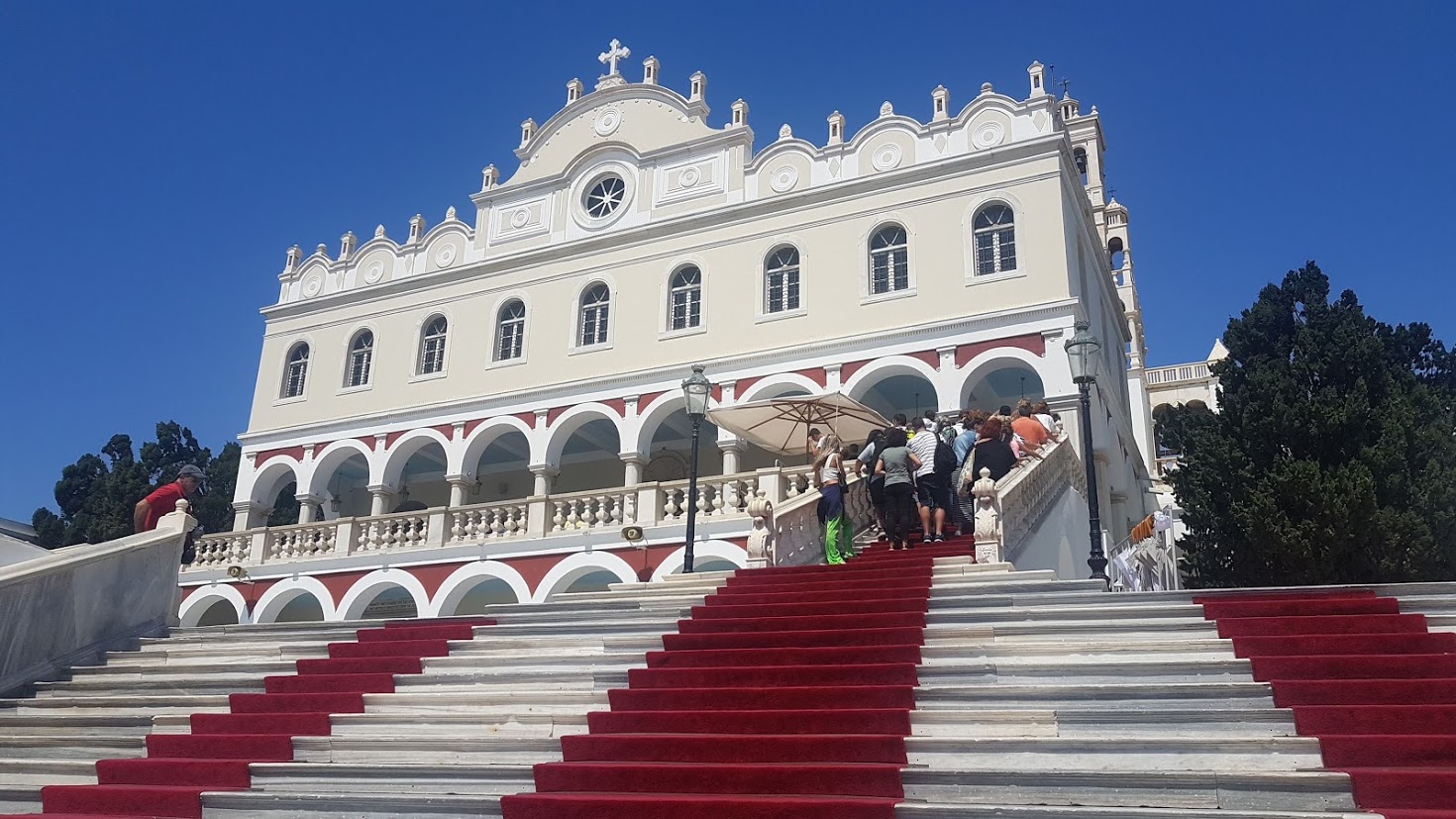
Tinos Island in Greece
The island of Tinos is an up and coming destination among foreign visitors. It’s located in the Cyclades, close to the popular Greek islands of Mykonos and Santorini.
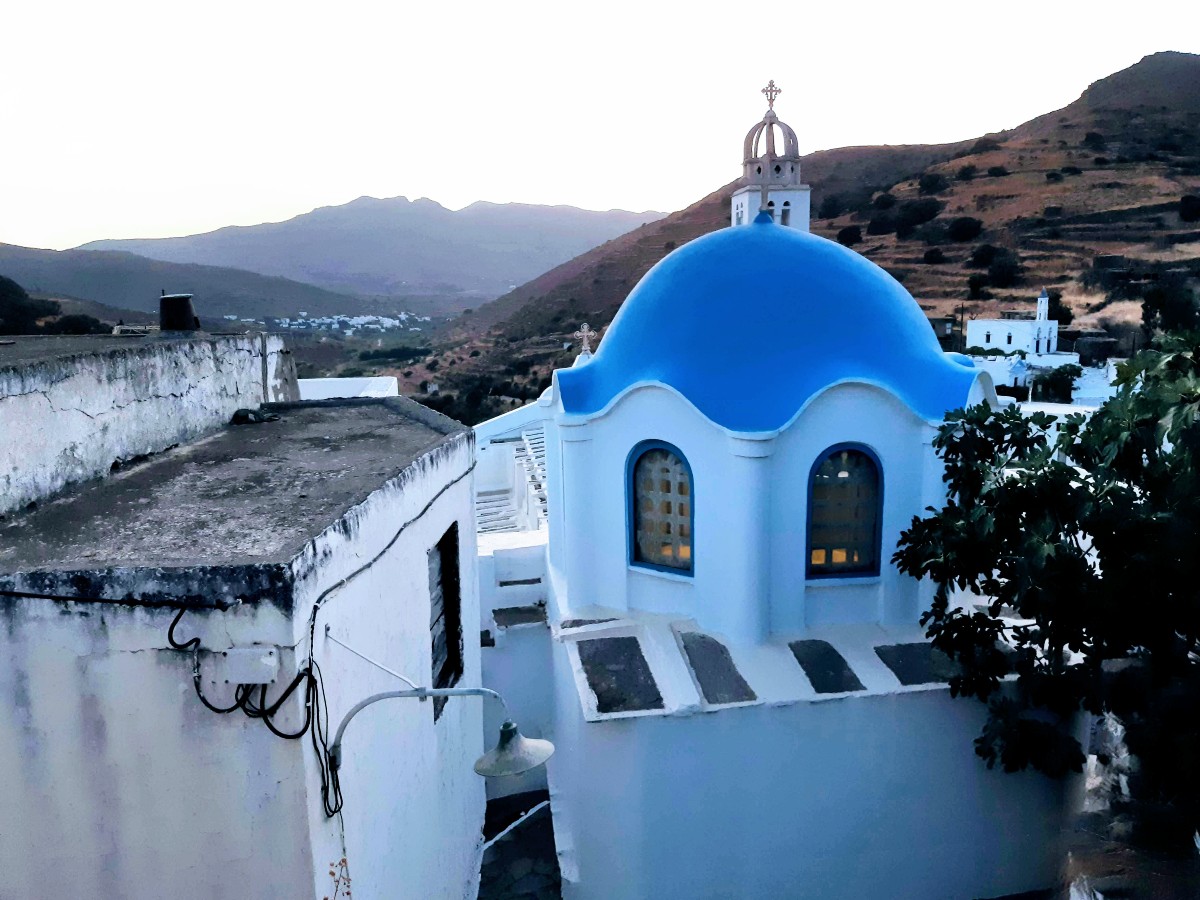
Tinos has beautiful beaches, unique landscapes and dozens of incredible, quaint villages. In addition, it is home to several hundreds of chapels, churches and monasteries. This includes the Panagia Evangelistria, one of the most iconic churches in Greece.
Among Greeks, Tinos is known as a religious island. Many Christians make a pilgrimage to the famous church of Panagia once in their lives. Here is everything you need to know about the iconic landmark.
Our Lady of Tinos Church
Our Lady of Tinos church is located in the port town, Chora. In Greek, we call it “Panagia Evangelistria”, “Megalochari” or “Panagia tis Tinou”. Panagia is the word we use for the Virgin.
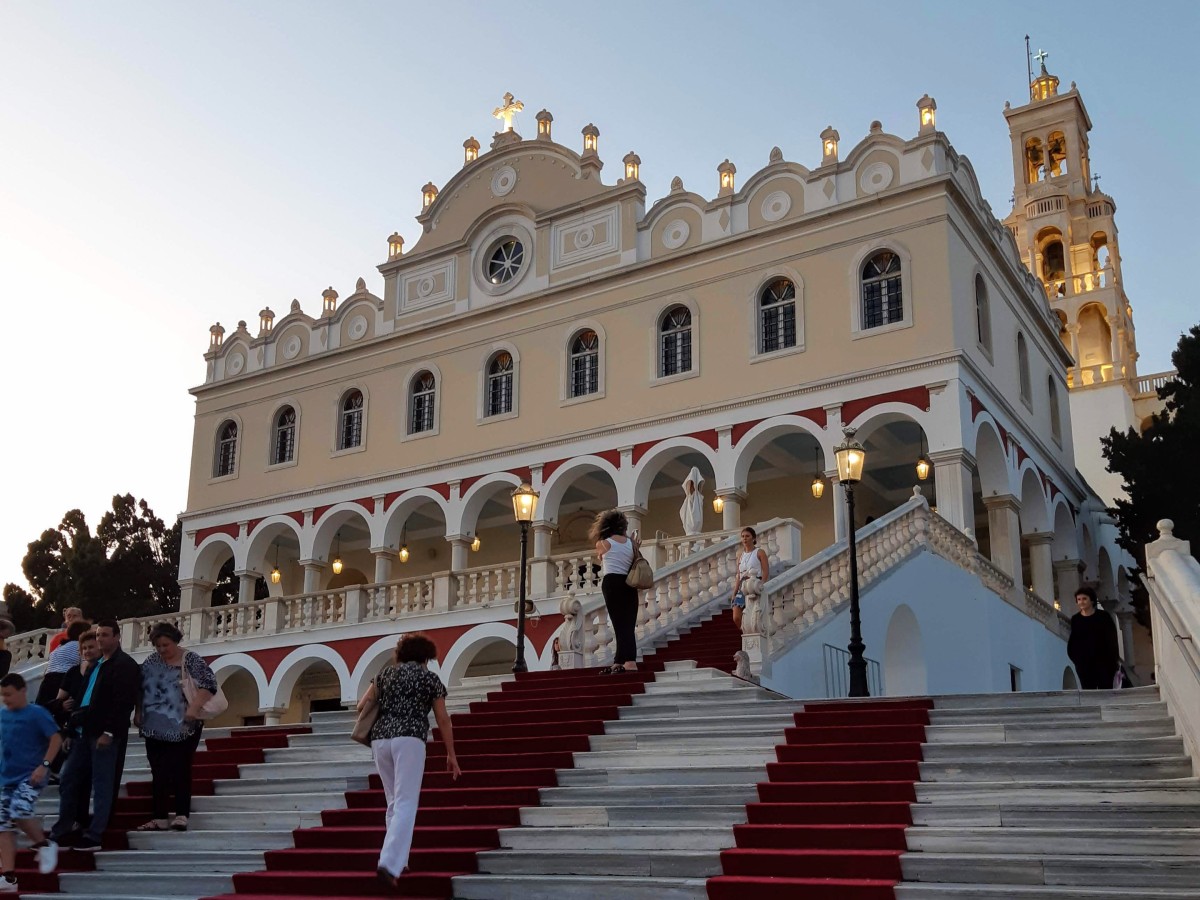
The Megalochari is a major pilgrimage center for Greek Orthodox Christians, attracting people from all over the world.
The Panagia Evangelistria celebrates a few times per year. The most important date is the Dormition of the Virgin, on the 15th of August. Thousands of people visit to pay their respects, and maybe ask for a wish to be granted.
Note – Whereas in Greek we use the phrase “Dormition of the Virgin” (Koimisis tis Theotokou), you will also find the phrases Assumption of the Virgin and Ascension of the Virgin.
History of Tinos Island Church
Like many churches and monasteries in Greece, the church of Panagia has an interesting story.
In July 1822, nun Pelagia, who lived in Kechrovouni Monastery in Tinos, had three dreams of Virgin Mary. In the dreams, the Virgin explained that Her miraculous icon was buried in a field. She then asked Pelagia to organize the excavation of the holy icon and the construction of a church.
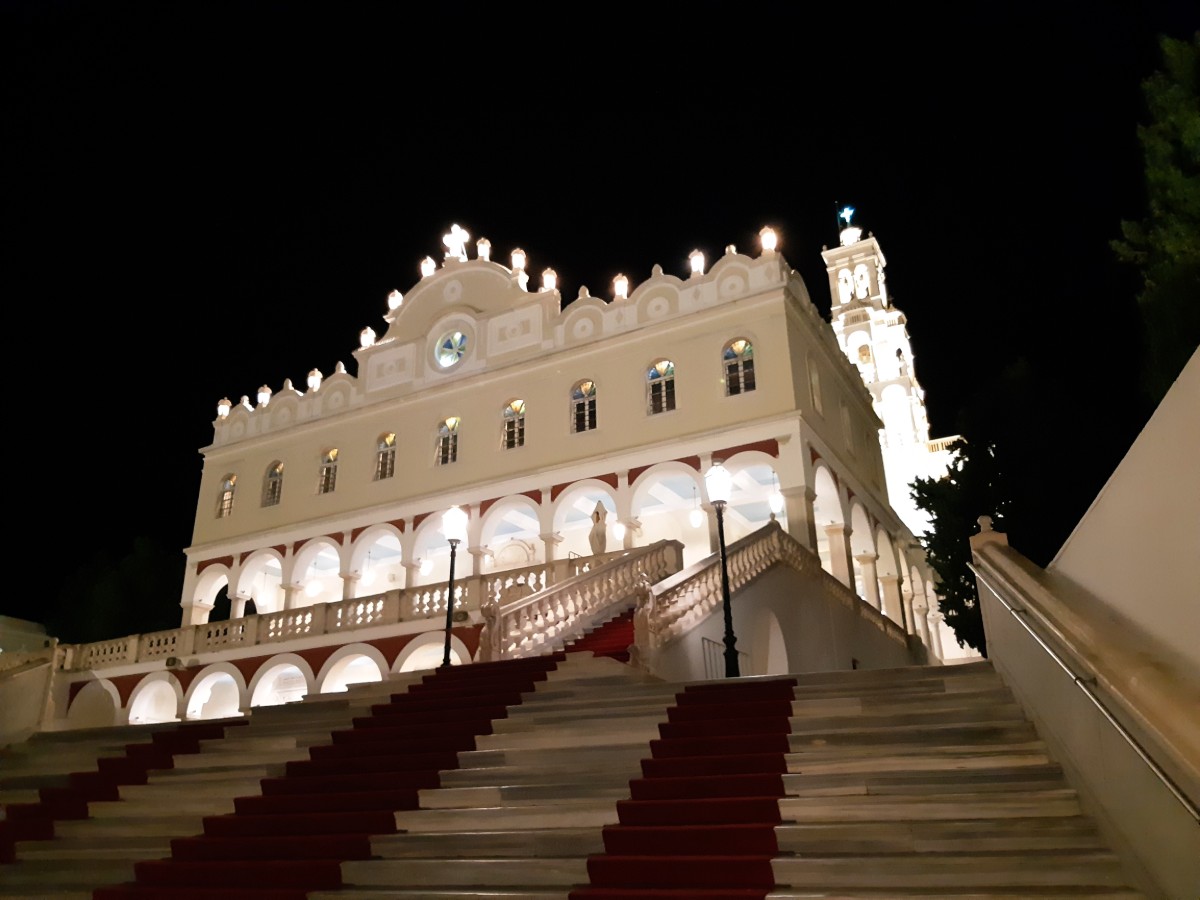
Soon afterwards, the procedures started. The Metropolitan Bishop, the local authorities and the people of Tinos were all involved in the search.
On 30 January 1823, the miraculous icon came to light. It depicted the Annunciation of the Virgin, with the Archangel Gabriel. Locals also discovered a spring of holy water on the site.
Tinos Church of Miracles
The icon was unearthed shortly after Greece’s Independence War against the Ottoman Empire. Its discovery was instantly received as a miracle, especially considering that the Cyclades hadn’t been liberated yet.
Discovering a Holy Icon was proof that the Revolution was happening for a just cause. It was also a definitive sign that the Cycladic islands were soon going to be part of Greece.
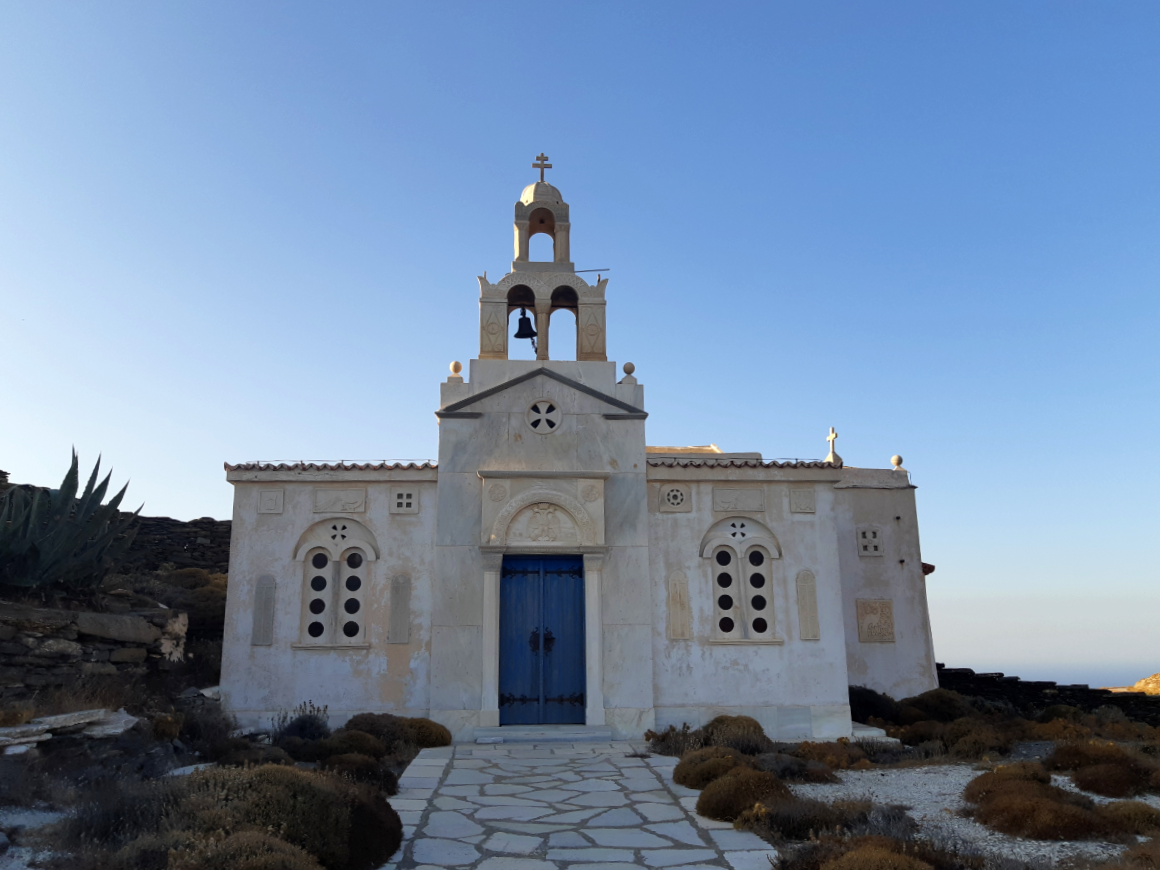
As the news broke out, people came from far and wide to worship the sacred icon. Several fighters of the Independence War also travelled to Tinos to pay their respects. These included Kolokotronis, Karaiskakis, Kanaris, Nikitaras and Miaoulis.
The Panagia Tinos church was built on the exact site where the icon was discovered. The materials used included marble from the nearby island of Delos. Tinos had many skilled marble workers, so there was no shortage of working hands.
The construction of the Panagia Tinos church was completed in 1826. The majestic courtyard was finalized several decades later, in 1880.
The Holy Icon inside our Lady of Tinos Church
Today, you will see the miraculous icon on your left-hand side upon entering the main church. You will also notice dozens of votive offerings, such as small metal plaques.

Many of these donations have been provided by people who experienced a miracle. All Independence warriors have also offered some of their personal belongings.
During the busiest times of the year, you will come across long queues of people waiting to go inside and pay their respects. The sacred water flows from a fountain inside the church, and many pilgrims bring a bottle to fill.
The Museums around Panagia Tinos Church
Inside the church complex, there are several rooms hosting important exhibitions. There are a couple of rooms on the ground level, and a few more on the fist floor. They are all free to visit, though sadly photos are not allowed.
Downstairs in the courtyard, there is a fantastic collection of Icons and Relics. This room contains several superb Byzantine icons, some of which are hundreds of years old.
On the ground level, you can also visit the Portrait Gallery, where you can see several paintings and portraits.

The rest of the exhibition rooms are upstairs. Arguably the most impressive one is the Sacristy. This room hosts an incredible array of ecclesiastical items, including silver objects and exquisite gold embroidery.
Many important Greek artists, such as Filippotis, Sohos, Lytras and Gizis, come from Tinos. The Museum of Tinian Artists contains paintings and sculptures by some of these prominent sculptors and painters. There is also a dedicated Antonis Sohos Museum, where you can see more works by the local sculptor.
The Elli Mausoleum in the Tinos Church of Miracles
Located next to the main church entrance, you will find the Elli Mausoleum. To appreciate this small monument, you would need to know the sad story behind it.
On 15 August 1940, on Dormition Day, thousands of people were in Tinos to honour the Virgin. At the time, Greece wasn’t yet involved in WWII.
Among the vessels participating in the religious celebrations was a Greek protected cruiser, named Elli. Out of the blue, an Italian submarine, Delfino, fired three torpedoes against the cruiser. One of them hit its target, resulting in 9 people being killed and 24 being wounded.
In order to avoid a conflict with Italy, the Greek government did not officially acknowledge the nationality of the submarine. Still, it was well known that it was Italian. After the war was over, Italy offered Greece a new cruiser, which was named Elli.
The small mausoleum in Panagia Tinou church was built in memory of the first victims of WWII in Greece. You can see a few objects that were on the original cruiser.

Down by the port, you can see another monument dedicated to the nine sailors who died at sea.
A Red Carpet for the Devout
The impressive church of Panagia is located up on a hill in Chora. You can’t fail to notice a long red carpet stretching across the town, all the way from the church entrance down to the port.
The carpet was installed for people visiting Tinos on a pilgrimage. After leaving the ferry, many of them head towards the church of Panagia on their hands and knees.
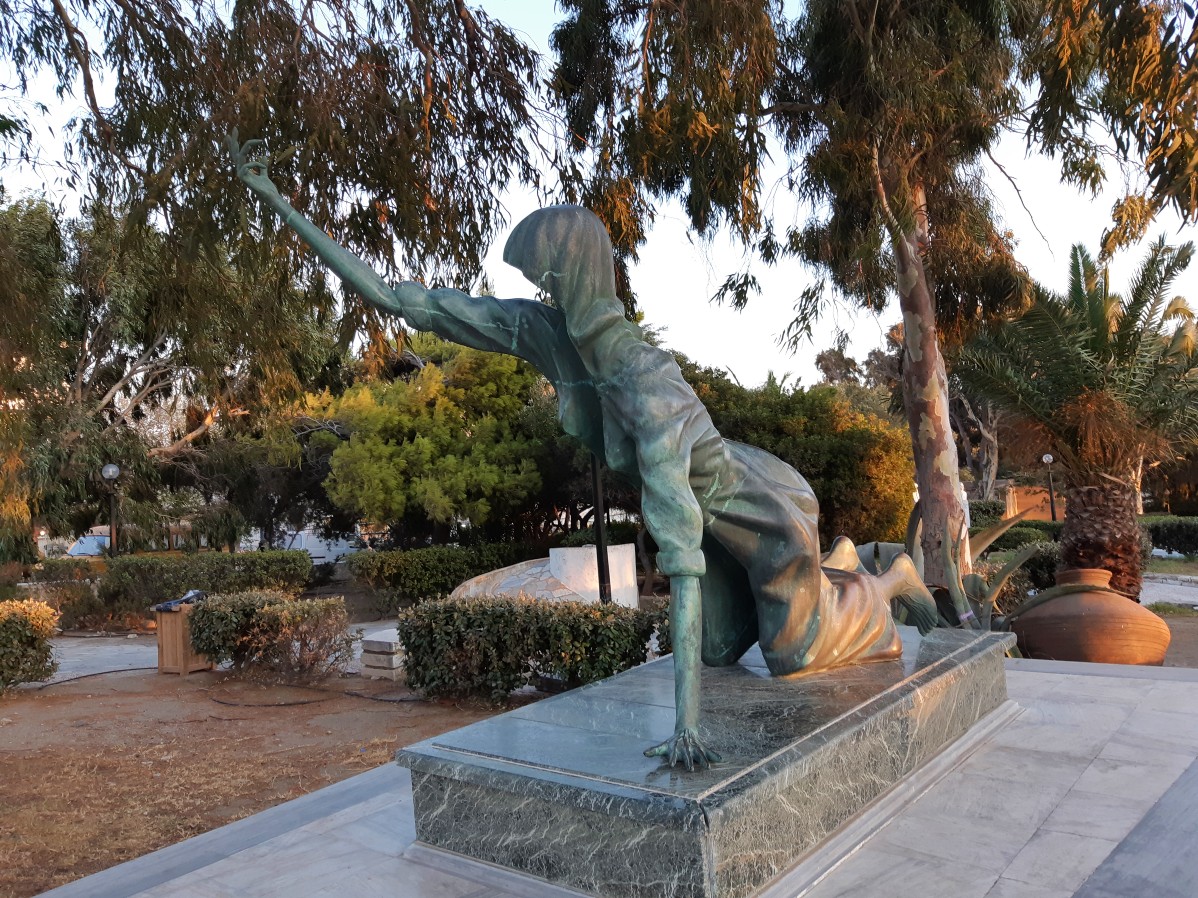
The Megalochari is open on a daily basis from early in the morning until late in the evening. It seems to be busier in the mornings, when some people visit on a day trip from Athens.
![]()
There are several souvenir shops around the church, where you can get copies of Byzantine icons. If you search around, you will find some icons of exceptional quality, decorated in gold. You can also buy small bottles, to fill with the Holy Water.
Note: These souvenir shops typically also sell evil eye charms, often used to protect someone of bad energy.
Special Celebrations at the Church of Virgin Mary
As mentioned earlier, the Megalochari celebrates a few times a year. Apart from the 15 August, other dates to remember are
- 30 January, the date when the icon was discovered
- 25 March, the day of the Annunciation of Virgin Mary
- 23 July, when nun Pelagia saw the third dream.
On these dates, there is a mass and a ceremonial procession of the icon in Chora Tinos. On 22 July, the icon is transferred to Kechrovouni monastery, where Pelagia lived. It is kept there for 24 hours, and is then returned to Panagia Tinos.
Finally, like all churches in Greece, the Megalochari celebrates Greek Easter. There are special masses during all weeks of Lent. The most important ceremonies happen during the Holy Week.
Easter at our Lady of Tinos Church of Miracles
Greek Orthodox Easter is a unique religious and cultural event, celebrated in every single town and village in Greece. The events on some of the Greek islands, like Corfu, Chios and Tinos, are spectacular.
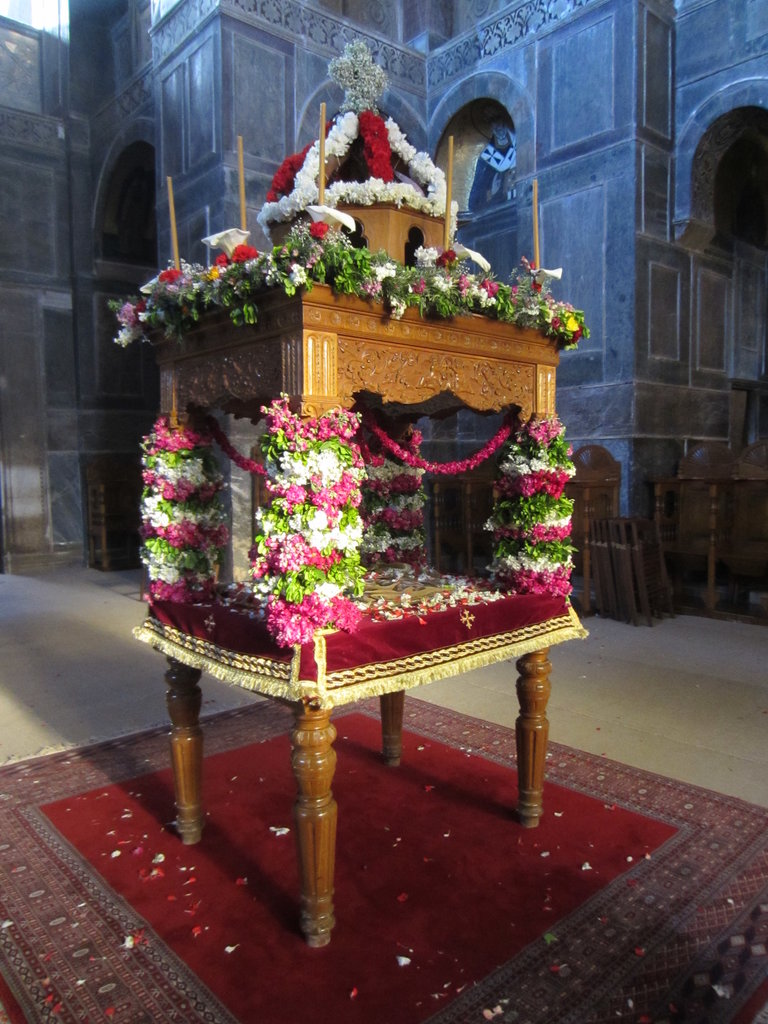
On the evening of Good Friday, people follow the Epitafios procession. It’s a solemn event, where everyone walks behind the Epitafios, a flower-clad representation of Jesus’ coffin. Like everywhere in Greece, the mass begins and ends in the church.
The midnight ceremony on Good Saturday, when the Resurrection happens, is an event of joy. Hundreds of people gather outside the church, expecting the Holy Light from Jerusalem. At midnight, the bells chime and the light spreads quickly among the congregation.
Here’s a little more about Greek Easter traditions. Includes everything you need to know about this major feast.
Lady of Miracles – Panagia Tinou
I hope that this article has shed some light on the Lady of Tinos church. If you have any questions, feel free to ask in the comments!

Hi! I am Vanessa from Athens, and I love helping people discover more about my country. The Cyclades are among my favourite Greek islands, and Tinos is simply amazing. You will fall in love with the villages, beaches, and all churches, monasteries and hundreds of chapels! For more information, check out our Real Greek Experiences guide book about Tinos and Andros!


hi, i visited one of the Greek Islands and was told that there was an incident decades ago whereby there was a Ferry which struck a Reef in the cold seas during winter and the damage was a hole in the hull of the ferry….the Passengers cried out Loud to Mother Mary to save them as they will die in cold waters of the sea if the ferry sank……the miracle was that a Dolphin or Whale swam itself into the hole and plugged the hole, sacrificing its own life and prevented the Ferry from sinking…. the Ferry managed to sail to the nearest island….. and the Passengers eventually built a church to give thanks to Mother Mary for saving their lives….. they hang incense burners in the shape of a Ship from the ceiling of this church….. WHERE IS THIS CHURCH IN GREECE ??? vincentowyong@gmail.com
I have tried hard to find the answer but not too sure this is what you are after. There’s a similar story where some sailors were saved back in the 1960s, as they were carried to shore by dolphins, after praying to the Virgin of Limni, in Evia island. However, it’s interesting that several ancient Greeks had been saved by dolphins, which is not too different from the story of Jonah, who was saved by a whale…
Hi, I have experienced miracle from our Lady of tinos church and I would like to donate some money from Australia? I was wondering how to do this?
Hello, I think the best way would be to contact them directly on their website, or on their FB page. This is their e-mail secretaria.kantam@gmail.com
Hi , I’m planning to visit Tino on the 1st July just to go to the Panayia and wanted to know if it will be open ?
Yes it will!
Thank you so much for posting this. My grandmother traveled from Basilico, near Kiato when she was a very young woman back in the early 1900’s. She wore a brace on her back because of an injury. Her father wouldn’t let her marry. When she went to the church, she saw a hand crossing over the top of the church. Only a few people saw it and exclaimed loudly. Others didn’t see it. She took off her brace and was healed. Went on to marry my grandfather, left for America in 1930. We heard her story many times over. Have others had this experience?
I’ve wanted to go. My brother got a brain tumor last year and all he wanted to do was to go to Tinos. The brain tumor took his life too quickly. He is now in the presence of the Lord.
Oh wow, thank you for posting this incredible story!! I’m really very sorry to hear about your brother… My condolences, and may he rest in peace. Please let me know if you ever visit Tinos or anywhere in Greece.
I want to make a few things clear for people who are not Orthodox Christians. Orthodox Christians do not worship icons themselves. We worship God. It can be easily confused as pagan idolization when one says “worship icons,” and “pay respects,” which Orthodox Christians do not do to icons. The icon is there as proof of God’s incarnation, and people venerate and kiss icons as one would kiss a photo of a loved one, they bring God and saints to mind, but we do not worship icons.
Secondly, “Greek Easter” is Orthodox Christian Pascha (which translates as Passover because Christ’s death happened right before that, but we are actually celebrating the liberation of Hades and the Resurrection). All Orthodox Christians around the globe celebrate Pascha and have traditions during the celebration season that are unique to each cultural group.
I wanted to make these comments to add to your article, which I found so helpful! I want to visit Tinos and crawl to the icon one day out of love for Panagia and to ask for her intercessions to God. Her prayers are the strongest!
Thanks so much for your comment Electra – I hope you can make it to Tinos soon, it’s a special place.
GREAT ARTICLE! My family and I will be going to Tinos in September for about 9 hours. I wanted to make a 5 day trip out of it, but it’s not going to happen this year. The best I could do was a quick layover on our way to another island. Do you know of any private tours of the Monestary? I’d be interested in one so I could learn the MAX about this incredible place. Thank you for your time!
Hi! Thank you so much for your message. I am afraid I don’t know of any tours of the church and museums, however please talk to the people who work there, they will be more than happy to give you information. Enjoy your visit!
… just back from a quick visit to Our Lady of Tinos. I only booked a day in Mykonos thinking I’ll make a visit from Santorini not realizing that it was just half hour from Mykonos. Left @ 10am back @ 12:50 ferry.
… I would have had an unfortunate experience of missing my ferry since there’s not a booth in the port to print the equivalent ticket that I purchased online for my return trip. Next ferry is at 5pm.
… Thank God and Our Lady, a sweet, kind French Lady, Melanie, drove me to the city center with just 17 minutes to boarding time. She was there to send her parents off to Mykonos who will catch a flight for Paris. Thinos is a small island. They have a house there for holidays.
… I can’t believe how an angel like her appeared to help me out. Small miracles happen everyday. 🙏🙏🙏